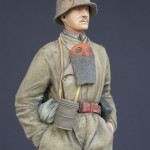
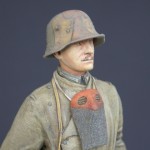
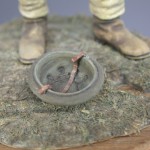
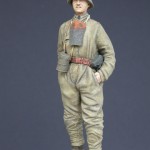
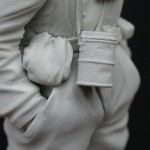
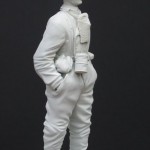
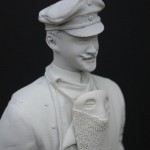
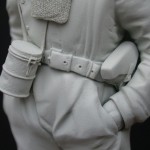
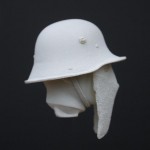
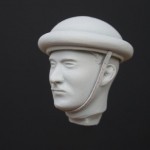
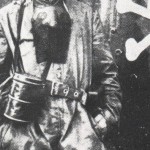
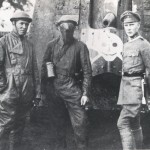
German Tank Crewman Kampfwagenabteilung 1, 1918
- Scale / Maßstab: 1:16
- Material: Resin
- Parts / Teile: 15
- Infosheet / Infoblatt: English
- Code: 14KFS
Contents / Inhalt:
- Figure (6 parts) / Figur (6 Teile)
- Alternative Head / 2. Kopf
- Gas Mask / Gasmaske M.17 Metallbehälter
- Cloth Bag / Stofftasche
- Armoured Face Mask / Splitterschutzmaske
- Pistol 08 / Pistole 08
- Leather Helmet / Special-Ledersturzkappe
- NCO / Officers Field Cap M1917 / Einheitsfeldmütze M1917
- Steel Helmet M.16 / Stahlhelm M1916
- Skull and Cross Bones Emblem / Totenkopf Emblem
- Figure Base / Figur-Sockel
Extracts from the Infosheet with this figure:
The name A7V derives from the department in the German War Ministry – Allgemeines Kriegsdepartement 7 Abteilung. Verkehrswesen (A7V), War Department, 7th Section, Vehicles, in which the tank project was assigned to. The abbreviation was kept on for security reasons. The first detachment, StPzKrW Abt. 1, was formed in the autumn 1917. Receiving the first A7Vs at Berlin-Marinefelde, on 05.01.1918 and just one week later it was transferred by rail to Sedan for 6 weeks tactical training. It was during this time that they trained along side SturmBtl “Rohr´´– the famous Assault Battalion Cadre, which first devised the German infantry assault tactics back in 1915. Over half of the crew members for the German tank arm were drawn from the Kraftfahrtruppen, or Motor Transport units. The rest were made up from Machine Gun (Infantry), Field Artillery and Signal units. Officers were aloud to keep their original regimental uniforms.
NCO / Officers Field Cap M1917 / Einheitsfeldmütze M1917: This is the later version of the grey NCO / Officers Field Cap. There were in fact many different types and forms of the field cap both privately purchased and official issue items. In order to simplify production on account of shortage of natural materials, especially leather it was decided to leave out many of the pre-war characteristics in later caps. From spring 1917 onwards the peak and chinstrap were no longer made from leather, but an Ersatz material, either vulcanised fibre or treated card, both finished in a matt grey tone. I have chosen to model an old type black leather chinstrap to give this otherwise grey in grey field cap some coloured contrast. The chinstrap at each side had either black metal (old type) or grey buttons. The coloured band and piping were from mid 1917 also officially issued in grey, although some caps were produced with band and piping in resedagrün, or mignoette (Reseda odorata), a type of greyish-green. Of cause these resedagrün caps were sought after and officers and NCOs valued the slight difference in appearance. The two metal Kokarden badges at the front were – top: Die Reichsfarben: black, white and red (from outwards to the centre) and – bottom: represents the state were the unit was raise – e.g. Prussia – Preussen: black, white and black. Bavaria – Bayern: white, light blue and white. Brunswick – Braunschweig: blue, yellow and blue. Hessen – Hessen: white, red and white etc.
Tank Overall / Panzerkraftwagen-Sonderbekleidung: The cloth tank overall had woven in asbestos fibre and was normally worn over the top of the uniform. A detachable hood was also issued, but seldom worn. On each shoulder were a cloth loop and a button for the attachment of shoulder straps. The overall generally had a baggy appearance. It is not sure if these tank overalls were issued to whole crews, or just tank commanders and motor transport and technical personal. Colour: there are few original photographs of this garment and to my knowledge no overalls exist today. Some books have described the suit as being made out of leather of a dark grey or black shade. The bulk of existing photos show the overall as being made out of a thin material, with a definite matt surface. On group photos of tank crews, the overalls seem to show nearly the same brightness and shade – maybe slightly darker – as the service dress tunics (Feldrock M1907/10 and Bluse M1915) worn by other crew members. Colour: grey.
Infantry Boots M1866 / Infanteristiefel M1866: The nailed infantry boots for other ranks were made out of leather and had a tendency to `winkle´ down around the ankles after being worn in. Depending on size they had between 35 and 45 nails in the sole and reinforced heel. On each side of the boot shaft are seams where the front and rear of the leather are joined together. Colour: at the beginning of the war the boots had a natural light tan, which was then often darkened by coats of dubbin. As per Army regulation September 1915, boots (and much of the other leather equipment as well) were issued in blackened leather.
Special Leather Helmet / Special-Ledersturzkappe: The leather helmet, like the tank overall is a rare object to find, either original, or in photographs. I managed to find a near identical flying helmet from 1911, in a local museum. The top dome part is made out of reinforced leather, with a padded rim on and around the bottom. Most photographs show tank crews, or flying and motor transport personnel wearing the more common Sturzhelm M1913, with an added pad running over the top of the helmet, from front to rear. There are 2 slits underneath, in between the helmet rim and pad for the attachment of the chin- strap (using card supplied) Colour: brown leather.
Steel Helmet M16 / Stahlhelm M.16: This helmet, which first entered service in 1916 during the initial stages of the battle of Verdun was designed by Professor Friedrich Schwerd and made from high quality chrome-nickel steel. Weighing between 950 and 1200g, depending on size – more heavier than the Allied helmets, but giving a better protection to the face, ears and neck. The horn venting bolts on each side enabled the fitting of an extra armoured shield over the helmet (also available in 1:16th scale from Jon Smith Modellbau) for sentries, MG troops, snipers or other particularly exposed / dangerous employment. This weighing around 2000g was seldom used; although a total of 50000 were supposedly produced.
Colour: issued in field- grey, which would reflect in sun light and proved unsatisfactory. Various trials were carried out, but it was not until July 1918 that an official camouflage scheme in brown and green sharp-edged irregular patens, all outlined in black was introduced. These were carried out by unit maintenance workshops (other weapons and equipment, particularly artillery pieces and MGs were also rendered in the same way). It seems that helmets were re-painted by individuals or units in a variety of colour schemes before the official order and items with red- brown, ochre (brownish- yellow), green and blue- grey, all outlined in black were common. Helmets were also covered using the light brown sandbag material, or the issued helmet-covers, seen particularly in the later war period.
The M.17 & 18 helmets followed with only slight differences to the inside padding and chin strap fasteners. The last model to see service during the war, if only in small numbers was the M.18 Ohrenausschnitt, or Helmet M.18 with ear cut-outs (also available in 1:16th scale from JSM), more commonly (and stubbornly) known as the Cavalry or Telegraph Helmet. The cut-outs were in fact a further design feature of the M.18 to improve the hearing ability of the wearer and avoid the hissing noise experienced by troops.
Gas Mask M17 Tin / Bereitschaftsbüchse 17 für Gasmaske M1917: The gas mask was kept in a metal container, which had a brown cloth / canvas strap. Troops serving in the front area often wore it in the alert position at the front of the chest. There was no room for the reserve filter in the container; this was normally kept in the bread bag. Through constant use the containers became easily dented. The seam on the side of tin is where the metal is joined together (not a cast line). There is a small indent, at the top of the figures right leg for the correct attachment of the gas mask tin (bottom rim – attachment loops facing inwards). Colour: grey or green-grey.
Armoured Face Mask: The British armoured face mask was issued to tank crews on account of the danger of `splash´ (small fragments and hot lead) entering the vision slits or coming off the inside of the vehicles when being hit by small arms fire. Just how often they were used is not known today, but certainly there is enough photographic evidence to suggest that they were more common than thought. These masks can still be found in many museums and at collectors markets. Inside the leather mask was a metal plate, with the eye slits cut out. The inside was padded and a piece of closely linked mail was attached to the outside to protect the rest of the face. Light cotton ties were used to fasten the mask to the wearer’s head – these can be made out of paper or something similar and glued into the small indents each side (inside) of the mask. The mask has been so constructed so as to fit either on the face, or in front of the chest. Colour: leather mask – dark reddish-brown. The metal eye slits – a dark brownish-metal. Mail – dark grey-metal.
Pistol 08 / P 08 (or Luger – the Germans never called this weapon the Luger – this is an anglicised name): The P 08 was first produced in 1900, with the German military taken it on in 1908 – hence the Pistole 08. As a service pistol it had its drawbacks, mainly it was expensive, difficult to produce and susceptible to dirt. Experienced front line NCOs and men preferred the larger or chunkier pistols as opposed to smaller pistols used by officers. Colour of holster: blackened leather.
The Base: The base supplied with the figure depicts a piece of ground, which Wagon 526 has just backed over. The A7V track imprints were scaled down from the in 1990 reconstructed A7V on display at the Tank Museum Munster, Germany. The only original A7V, still existing is Wagen 506 “Maphisto´´ at the Queensland Museum in Brisbane, Australia.
Skull and Cross Bones Emblem / Totenkopf Emblem: The skull and cross bones emblem was used by Abt. 1 and painted in white onto the front armoured plate of the A7Vs, directly under the cannon. The emblem could be placed onto the figure base, or fixed to the front of a wooden plinth. The original emblems were about 60 cm in width, so the one supplied is not in scale with the figure.
 An deutschsprachige Interessenten:
Sie können mich per eMail oder Telefon auch gerne auf deutsch kontaktieren. Ortsbesuch ist nach Absprache möglich.
An deutschsprachige Interessenten:
Sie können mich per eMail oder Telefon auch gerne auf deutsch kontaktieren. Ortsbesuch ist nach Absprache möglich.
